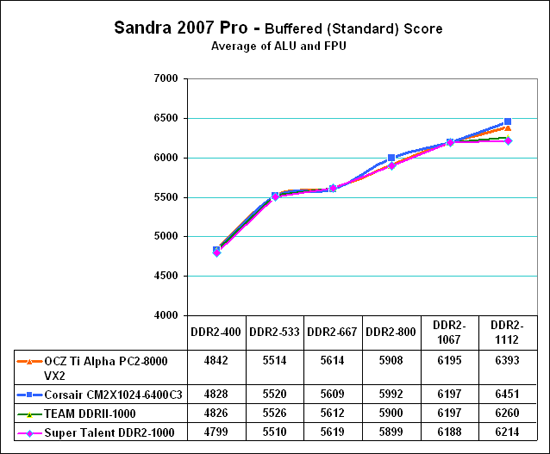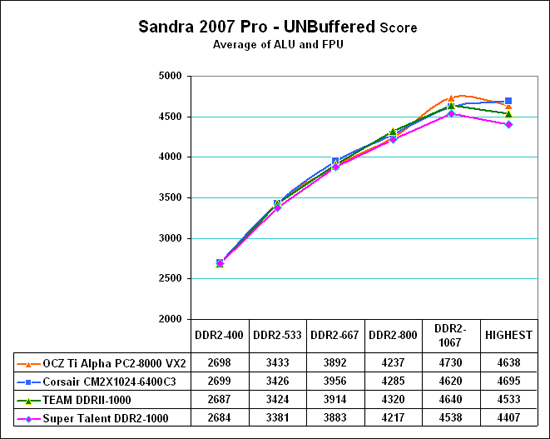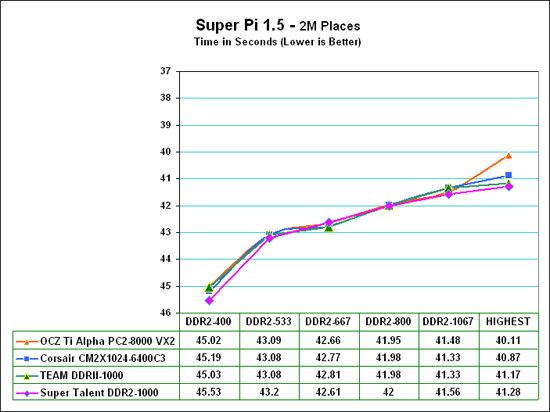Super Talent & TEAM Join the Fast DDR2 Club
by Wesley Fink on October 10, 2006 4:00 AM EST- Posted in
- Memory
Memory Bandwidth and Scaling
Everyone should already know that memory bandwidth improves with increases in memory speed and reductions in memory timings. We first used the new Memory Performance Scaling charts in our comparison of DDR2 memory on AM2 and Core 2 Duo processors. They worked well to compare both Memory Bandwidth and Memory Performance over a wide range of DDR2 speeds. To evaluate memory bandwidth SiSoft Sandra 2007 Professional was used to provide a closer look at scaling for fast DDR2 memory.
Since the results were so close at all tested speeds, the scale range was reduced to better show the small differences in these memories. Please keep this in mind when viewing the charts, since a normal zero scale would make performance differences appear much smaller than these expanded scale charts. Values for each memory at each speed are included below each chart for reference.

The most widely reported Sandra score is the Standard or Buffered memory score. This benchmark takes into account the buffering schemes like MMX, SSE, SSE2, SSE3, and other buffering tools that are used to improve memory performance. Buffered bandwidth performance of the TEAM and Super Talent DDR2-1000 memory was virtually the same as the previously tested Corsair and OCZ to DDR2-1067. At the very top the better overclocking OCZ and Corsair pull away.
The Buffered benchmark does not correlate well with real performance in games on the same computer. For that reason, our memory bandwidth tests have always included an Unbuffered Sandra memory score. The Unbuffered result turns off the buffering schemes, and we have found the results correlate well with real-world performance.

In Unbuffered tests we see the real bandwidth differences among the four tested memories. The TEAM pretty much mirrors the Corsair 6400C3 and OCZ PC2-8000 to DDR2-1067. The Super Talent, which requires slightly slower timings at many speeds, is a little lower on bandwidth than the other three. At the highest speeds the OCZ and Corsair top the bandwidth, as we would expect from the better overclocking memories.
We also compared pure number crunching with Version 1.5 of Super Pi - comparing the time to calculate 2 million places of Pi at the different memory speeds.

The most striking result in comparing Super Pi results is that performance continues to improve all the way to the highest speed that could be reached with stability with each memory. The second result that stands out is that the Super Talent drops off a bit at the top and bottom - where it required slightly slower timings for stable operation than the other three tested memories. Even though these performance differences are extremely small, they still show up on Super Pi scaling charts, showing the sensitivity of Super Pi as a measurement of memory performance
Everyone should already know that memory bandwidth improves with increases in memory speed and reductions in memory timings. We first used the new Memory Performance Scaling charts in our comparison of DDR2 memory on AM2 and Core 2 Duo processors. They worked well to compare both Memory Bandwidth and Memory Performance over a wide range of DDR2 speeds. To evaluate memory bandwidth SiSoft Sandra 2007 Professional was used to provide a closer look at scaling for fast DDR2 memory.
Since the results were so close at all tested speeds, the scale range was reduced to better show the small differences in these memories. Please keep this in mind when viewing the charts, since a normal zero scale would make performance differences appear much smaller than these expanded scale charts. Values for each memory at each speed are included below each chart for reference.

The most widely reported Sandra score is the Standard or Buffered memory score. This benchmark takes into account the buffering schemes like MMX, SSE, SSE2, SSE3, and other buffering tools that are used to improve memory performance. Buffered bandwidth performance of the TEAM and Super Talent DDR2-1000 memory was virtually the same as the previously tested Corsair and OCZ to DDR2-1067. At the very top the better overclocking OCZ and Corsair pull away.
The Buffered benchmark does not correlate well with real performance in games on the same computer. For that reason, our memory bandwidth tests have always included an Unbuffered Sandra memory score. The Unbuffered result turns off the buffering schemes, and we have found the results correlate well with real-world performance.

In Unbuffered tests we see the real bandwidth differences among the four tested memories. The TEAM pretty much mirrors the Corsair 6400C3 and OCZ PC2-8000 to DDR2-1067. The Super Talent, which requires slightly slower timings at many speeds, is a little lower on bandwidth than the other three. At the highest speeds the OCZ and Corsair top the bandwidth, as we would expect from the better overclocking memories.
We also compared pure number crunching with Version 1.5 of Super Pi - comparing the time to calculate 2 million places of Pi at the different memory speeds.

The most striking result in comparing Super Pi results is that performance continues to improve all the way to the highest speed that could be reached with stability with each memory. The second result that stands out is that the Super Talent drops off a bit at the top and bottom - where it required slightly slower timings for stable operation than the other three tested memories. Even though these performance differences are extremely small, they still show up on Super Pi scaling charts, showing the sensitivity of Super Pi as a measurement of memory performance










16 Comments
View All Comments
Wesley Fink - Tuesday, October 10, 2006 - link
As I stated in the review, we have yet to see a value DDR2-800 that will run at DDR2-1067. The value parts we have tested with Elpida chips can achieve 4-3-3 timings at DDR2-800. We tested and showed results in the Conroe Buying Guide. Part 2 of that guide is in the works and will include more value RAM.Guuts - Tuesday, October 10, 2006 - link
Thanks Wes.deathwalker - Tuesday, October 10, 2006 - link
These modules certainly appear to be a "no go" for most of the 1.8 vlt. C2D platforms...and there certainly seem to be many of them out there that only offer modest voltage settings above 1.8 vlts.Gary Key - Tuesday, October 10, 2006 - link
This would have been true early on with most of the P965 boards. However, as the bios and memory SPDs have matured this is no longer the case for the vast majority of P965 boards. I have not had an issue with the high end PC2-8000 and up modules booting properly at this time in most of the P965 boards with the latest bios, the lone exception being the Intel branded boards. However, unless you have a E6300/E6400, a very overclocking friendly board, and are benchmarking for money then there are better choices in the DDR2-800 family for the P965 setup. ;-)duploxxx - Tuesday, October 10, 2006 - link
We all know memory performance is much more important on AM2, so what's the point on reviewing it only on Core.You should add the performance benches of the fx to this chart. But I am sure you won't. Because many know what will happen to the performance crown when using such memory to the AMD system (without the trick of lowering cas to memoryspeed you did in your performance king review), but marketing is at a whole other level these days.....
Wesley Fink - Tuesday, October 10, 2006 - link
I stated in the review that AMD bandwidth goes up more than Core2Duo as memory speed increases. We showed that in our C2D vs. AM2 article. However, even with the massively increased bandwidth AM2 performance does not increase accordingly - and we also showed that in our earlier review. The fact is that the current AM2 design is not memory bandwidth starved, so the memory bandwidth improvements have almost no impact on performance. In the future AM2 die-shrink, with perhaps a memory controller update, we might see AM2 make better use of it's memory bandwidth advantage. When that happens, we will definitely report it.